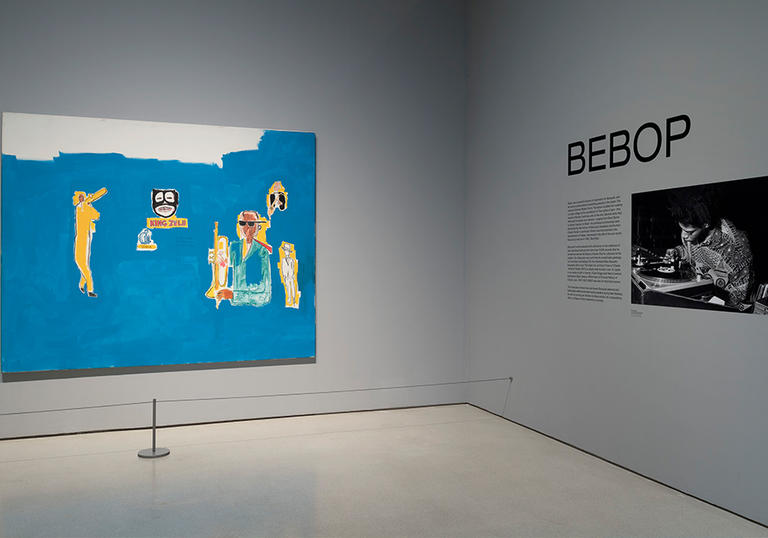Throughout the exhibition, we’ll be taking a closer look at some of the works you’ll see in the gallery to understand more about the range of influences that inspired and stimulated Basquiat’s practice as well as some of the themes that recur in many of his artworks.
To celebrate EFG London Jazz Festival taking place this week, we explore the way Basquiat infused his work with the spirit and energy of jazz, from his musical heroes to its rhythm and notation.
Jean-Michel Basquiat, King Zulu, 1986
The floating fragments in King Zulu were sourced from Black Beauty, White Heat: A Pictorial History of Classic Jazz (1982) by Frank Driggs and Harris Lewine.
Tip: You can see Basquiat’s original copy of 'Black Beauty, White Heat' in the showcase, opposite this painting in the Gallery.
Below the grinning mask, you’ll see the title of the painting - the eponymous King Zulu. This relates to Louis Armstrong who was crowned ‘King Zulu’ at the Mardi Gras parade in 1949. While Armstrong saw this as a great honour, Basquiat treats the exaggerated blackface costume with clear ambivalence.
Barely legible beneath the paint is the phrase ‘DO NOT STAND / IN FRONT OF / THE ORCHESTRA’, which appears within a photograph of Armstrong’s orchestra in the book. The gothic ‘G’, meanwhile, belongs to Gennett Records, which recorded Armstrong’s first solo as second cornet in Joe Oliver’s Creole Jazz band in April 1923. In underlining these references, Basquiat connects to the practice of citation or ‘licks’ in the performance of jazz.
Jean-Michel Basquiat, Untitled (Charlie Parker), 1983
This drawing is another tribute to Charlie Parker, whose pioneering experiments in jazz greatly influenced Basquiat. The depiction of Parker dressed in a polka dot necktie with his saxophone has a striking resemblance to the photograph on the front of Parker’s historic ‘Koko Sessions’ record, released in 1945 by Savoy. Another possible source is a promotional photograph included in Basquiat’s beloved copy of Ross Russell’s Bird Lives! biography, displayed nearby in the Gallery. The ‘Koko Sessions’ recording was Parker’s first session as a bandleader and the phrase is inscribed, outlined and then crossed out on Untitled (Charlie Parker) to draw particular attention to its importance.
The first bars from the beginning of the theme of the song ‘Red Cross’, one of the great examples of early bebop recorded by Parker and guitarist Lloyd ‘Tiny’ Grimes, are also drawn below the staves.
Jean-Michel Basquiat, Self-Portrait, 1981
There are two faces staring at you in this work – one embellished with menacing red crayon around the eyes and mouth, the other silenced with a blacked-out mouth. This striking image conveys a sense of a divided self.
On the left, you’ll notice the repeated name of Ben Webster, the jazz tenor saxophonist, and to the right are song titles of Thelonious Monk, the pianist and composer who was among those to pioneer the new sound of bebop. Placing himself in the lineage of these musical heroes, Basquiat seems to question the limited recognition of the achievements of black artists.
Basquiat: Boom For Real took place from 21 September–28 January 2018

